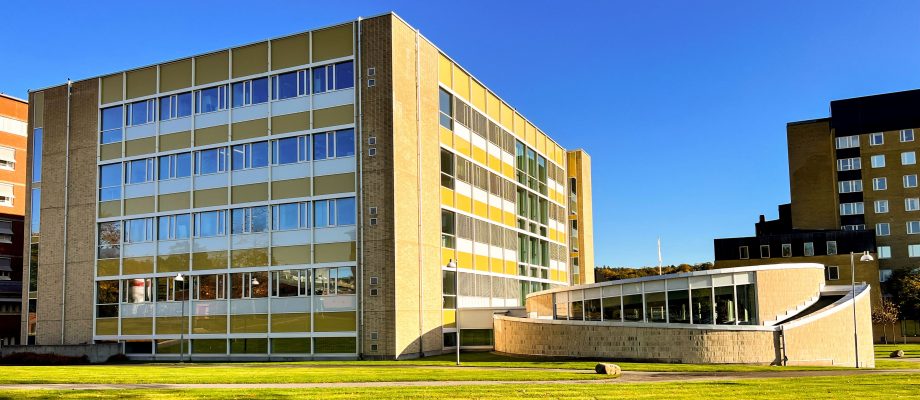RESEARCH. For forty years, the IngaBritt and Arne Lundberg Research Foundation has invested heavily in orthopedic research in Gothenburg, something that has been crucial for bringing orthopedics together and allowing the field to flourish. Join us on a visit to the recently completed R Building at Mölndal Hospital.
The R Building is bathed in sunlight during my visit to Mölndal Hospital on this chilly October morning. Since opening five years ago, the building has been home to highly specialized research, teaching, and conference facilities. The auditorium, which stretches out like a wave-shaped extension, gives the building its character.
Integrated with the clinic
The R Building is a joint teaching resource for all of Sahlgrenska University Hospital and brings together the University’s orthopedics-related work. Subject representative Professor Ola Rolfson notes that the R Building realized a long-term strategy of bringing together education and research.
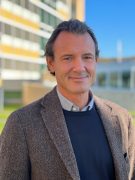
“Under the research unit in the R Building, we have brought together expertise, laboratories, and equipment that were previously spread across the hospital. It is a clear resource for anyone working with research. It has also strengthened the link between clinic and research. In orthopedics, the organization’s management at both the hospital and the University now sit in the same corridor and everyone who works clinically is encouraged to also participate in research,” says Ola Rolfson, as he guides me through the bright and airy premises.
Strategic concentration of resources
The letter R in the name of the building could be said to stand for research, particularly on the back. Back research has a long and successful history in Gothenburg, where research is ongoing on how the muscles in the lumbar part of the back work and how to improve different surgical methods, such as using laparoscopy for herniated discs. Biochemical back research is also conducted on herniated discs and how the discs of the back can be stimulated to regenerate. The R Building also hosts both a biomechanical laboratory, where researchers and others study how much load a hip joint or a vertebra can withstand, and a function laboratory, where the function of joints, tendons, and muscles can be studied from different aspects. The Swedish Fracture Register is also administered from here.
We drop by the Gait Lab, which is full of technology to measure and analyze patient movement patterns: a large number of cameras, pressure sensors in the floor, and advanced computer equipment. Animated 3D models of filmed patients are created and analyzed with sensors attached to strategic places on the body. The Gait Lab was originally located in the Unit for Orthopedic Technology in Örgryte and then moved to the Lundberg Laboratory in the Sahlgrenska area. Thanks to grants from the Lundberg Foundation, however, it has now moved into specially adapted premises in the R Building.
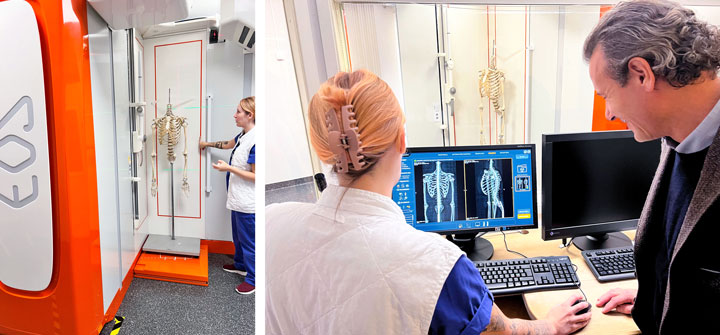
A Rolls-Royce at the X-ray Department
Over the years, many orthopedic researchers, including Professor Henrik Malchau, have also received large grants from the Lundberg Foundation, making it possible to upgrade the instruments. In total, the Lundberg Foundation has awarded grants of around SEK 7 million, which paid for the purchase of the EOS advanced imaging instrument. This large instrument has now been fully installed in the X-ray Department, right next to the R Building, since last spring.
The instrument will be used widely in research and is predicted to have enormous importance for the orthopedics department. With a single instrument, researchers can now create a three-dimensional image of the entire skeleton, which would require several images with traditional technology that would then also need to be combined manually. The radiation dose is only 20 percent compared with conventional x-rays.
Wide use
In addition to this instrument saving a lot of time and being considerably easier on patients, it also allows imaging patients standing or sitting.
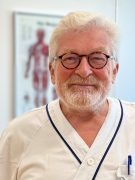
“When we conduct examinations with computer tomography, patients are almost always lying down. However, to obtain an accurate picture of the load on, for example, the pelvis and lower back, images need to be taken while patients are standing or walking. The equipment will be widely used in orthopedic research, such as for examinations of scoliosis in both children and adults, the body’s load axis, and after treating fractures,” says Henrik Malchau.
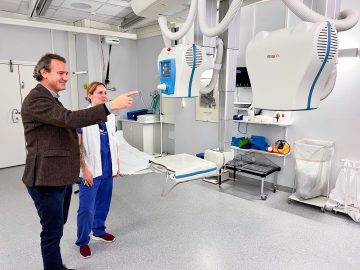
Interest in using the new technologies in research is considerable. For now, it is only available for imaging for research purposes, but eventually, it is hoped that significantly more patients can be imaged with EOS.
An adjacent room has another advanced three-dimensional x-ray technology: RSA (radiostereometric analyses). The technology means that small metal markers are surgically inserted into patient prostheses are registered with ordinary x-rays in two projections, which are then used to calculate three-dimensional movements. RSA is used to measure healing, wear, and micro-movements of hip and knee joint prostheses in particular.
The first grant went to orthopedics
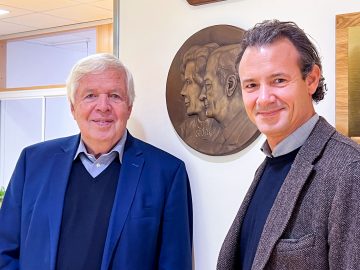
The Lundberg Foundation was established in 1982 and is celebrating its 40th anniversary this year. Orthopedic research in western Sweden is a priority area for the research foundation. In 1983, Ortopedin became the recipient of the first large grant, which came from a donation by the couple IngaBritt and Arne Lundberg. Since then, several large contributions from the Lundberg Foundation have made it possible for the orthopedics department in Gothenburg to pool resources.
“Before the grants from the Lundberg Foundation, there was no joint organization. The first donation meant we could update our biomechanical laboratory, and in the 1990s we received very generous funding to establish the Lundberg Laboratory for Orthopedic Research. For the first time, orthopedic research was brought together under a single unit in the Sahlgrenska area,” says Björn Rydevik, senior professor in orthopedic surgery. “It is not possible to emphasize enough how important the Lundberg Foundation has been for the strong position that orthopedic research has today in Gothenburg. We are extremely happy and grateful for this.”
BY: ELIN LINDSTRÖM

